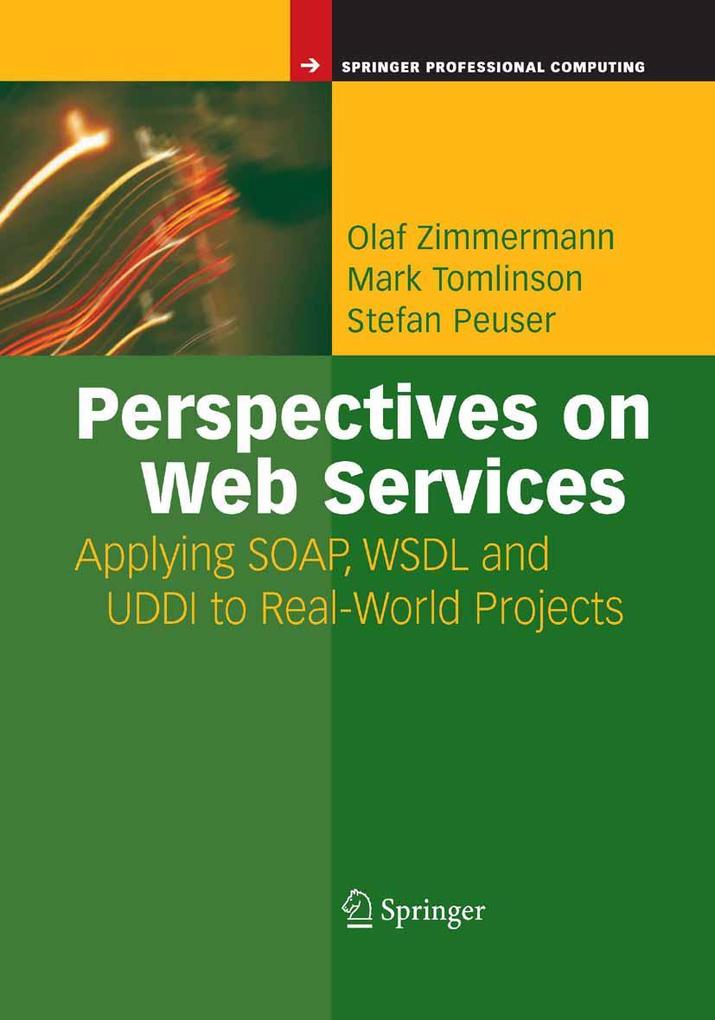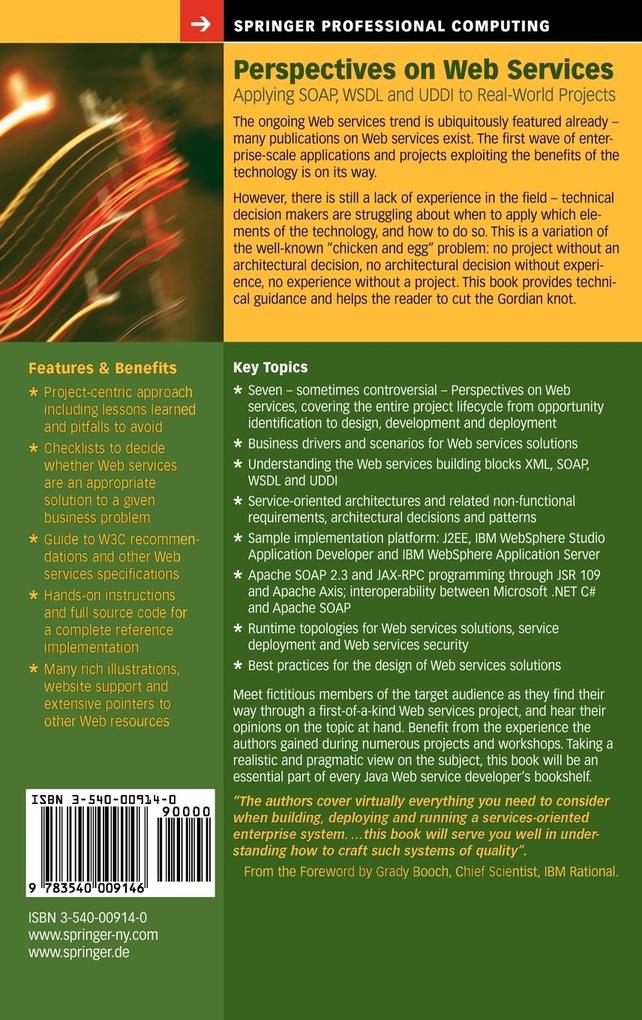
Zustellung: Do, 24.07. - Mo, 28.07.
Versand in 7 Tagen
VersandkostenfreiBestellen & in Filiale abholen:
Contains everything that a project team needs to know about the development and deployment of Web services with the IBM WebSphere product family. Included will be examples for all development artifacts in a format that can be reused in the reader's project. It combines the authors' own practical experiences with consolidated information on the latest product capabilities in a unique approach that allows the book to be easily accessible to a broad spectrum of readers. Finding a balance between a euphoric/optimistic and down-to earth/realistic view on the subject, this book will be an essential part of every Web service developer's bookshelf.
Inhaltsverzeichnis
1 The Business Perspective. - 1. 1 The Sponsor's View. . . and a Few Other Opinions l. - 1. 2 Web Services Holy Grail or Déjà Vu? . - 1. 3 Usage Scenarios. - 1. 4 Potential Inhibitors. - 1. 5 Introduction to the Case Study. - 1. 6 Summary. - 2 The Training Perspective. - 2. 1 The Trainer's View. . . And What the Trainees Think. - 2. 2 Web Services Concepts in a Nutshell. - 2. 3 XML, XML Namespaces and XML Schema. - 2. 4 Understanding SOAP. - 2. 5 Understanding WSDL. - 2. 6 Understanding UDDI. - 2. 7 Summary. - 3 The Architecture Perspective. - 3. 1 The Architect's View. - 3. 2 Introduction to Web Services Architectures. - 3. 3 Web Services Principles and Patterns. - 3. 4 Architectural Decisions. - 3. 5 Non-Functional Requirements (NFRs). - 3. 6 Gaps and Countermeasures. - 3. 7 Frequently Asked Questions. - 3. 8 Summary. - 4 The Development Perspective. - 4. 1 A Developer's View. - 4. 2 Introduction to Developing Web Services in Java. - 4. 3 Preparing the Sample Application. - 4. 4 Building rpc/encoded Services from Java. - 4. 5 Building Web Service Clients. - 4. 6 Building rpc/encoded Services from WSDL. - 4. 7 Programmatic Access to WSDL. - 4. 8 Using WS-Inspection to Build Service Indices. - 4. 9 Using UDDI. - 4. 10 Using Other Web Services Bindings. - 4. 11 Creating a document/literal Service from WSDL. - 4. 12 Creating a document/literal Service Client. - 4. 13 Orchestrating Web Services. - 4. 14 Using Attachments with SOAP. - 4. 15 Using SOAP Headers. - 4. 16 Exporting the Completed Sample. - 4. 17 Summary. - 5 The Operational Perspective. - 5. 1 The System Administrator's View. - 5. 2 System Architectures for Web Services Solutions. - 5. 3 Deploying Web Services. - 5. 4 Securing a Web Services Implementation. - 5. 5 The Web Services Gateway. - 5. 6 Summary. - 6 The Engagement Perspective. - 6. 1 The Project Manager's View. - 6. 2 Planning a Web ServicesDevelopment Project. - 6. 3 Lessons Learned and Design Advice. - 6. 4 Summary. - 7 The Future Perspective. - 7. 1 An Optimistic and a Pessimistic View. - 7. 2 Emerging Specifications. - 7. 3 Web Services and Grid Computing. - 7. 4 A Quick Look at the Semantic Web. - 7. 5 Concluding Thoughts. - A Creating the Sample Applications. - A. 1 Building the PremierQuotes Policy System. - A. 1. 1 Configuring a Cloudscape Environment. - A. 1. 2 Creating a New Database. - A. 1. 3 Creating the Project Structures in WebSphere Studio. - A. 1. 4 EJB-RDBMS Mapping Approaches. - A. 1. 5 Creating the Database Schema. - A. 1. 6 Generating Entity EJBs from the Database Schema. - A. 1. 7 Creating a WebSphere Server to Deploy the Application. - A. 1. 8 Binding the EJBs to the New Data Source. - A. 1. 9 Populating the Database with Sample Data. - A. 1. 10 Data for PremierQuotes Cloudscape Database. - A. 2 Updating the PremierQuotes Policy System. - A. 2. 1 Completing the Entity EJB Implementations. - A. 2. 2 Creating the Session EJB. - A. 2. 3 Creating Value Objects to Return from the Session Bean. - A. 2. 4 Inserting the Business Logic. - A. 2. 5 Creating a Local EJB Reference to the Address Entity. - A. 2. 6 Deploying the Application. - A. 2. 7 Testing the New PremierQuotes Policy System. - A. 3 Building the DirtCheap Policy System. - A. 3. 1 Creating the New Database. - A. 3. 2 Creating the Project Structure in WebSphere Studio. - A. 3. 3 Copying a Database Schema. - A. 3. 4 Defming a New JDBC Data Source. - A. 3. 5 Deploying the New Enterprise Application. - A. 3. 6 Populating the Database with Sample Data. - A. 3. 7 Data for DirtCheap Insurance Cloudscape Database. - A. 4 Updating the DirtCheap Policy System. - A. 4. 1 Building JDBC Wrappers. - A. 4. 2 Defming a JDBC Resource Reference. - A. 4. 3 Testing the New DirtCheap Insurance Policy System. - A. 5 Configuring the WebSphere SDK for Web Services. - A. 5. 1 Setting up the Command Line Environment. - A. 5. 2 Updating the Server Classpath. - A. 5. 3 Changing the Default Classloading Behavior. - A. 5. 4 Resolving Problems with the Default UDDI Data Source. - A. 5. 5 Changing Java 2 Security Privileges for Libraries. - A. 5. 6 Configuring the Application Server. - A. 5. 7 Installing the Universal Test Client. - A. 5. 8 Script to Remove JDBC Providers. - B Java to XML Mapping Reference. - B. 1 Apache SOAP 2. 3 Mappings. - B. 2 JAX-RPC Mappings. - C Appendix C#. - C. 1 Overview to Building. NET Web Service Clients. - C. 2 Developing rpc/encoded Clients in C#. - C. 3 Developing document/literal Clients in C#. - Sources of Information. - References. - Trademarks. - Copyright Notices.
Produktdetails
Erscheinungsdatum
17. Juli 2003
Sprache
englisch
Auflage
2003
Seitenanzahl
684
Autor/Autorin
Stefan Peuser, Mark Tomlinson, Olaf Zimmermann
Verlag/Hersteller
Produktart
gebunden
Abbildungen
XXXII, 648 p.
Gewicht
1180 g
Größe (L/B/H)
241/160/41 mm
ISBN
9783540009146
Entdecken Sie mehr
Pressestimmen
" Web Services have emerged as a powerful tool for building complex but adaptive and agile enterprise systems in heterogeneous environments, enabling effective inter- and intra-enterprise integration. Perspective on Web Services: Applying SOAP, WSDL, and UDDI to Real-World Projects by Olaf Zimmermann, Mark R. Tomlinson, and Stefan Peuser contains erverything you need to know about developing and deploying Web services-oriented enterprise applications. Whatever your role in a Web Services application project - for example, software architect, developer, project manager, or systems administrator - you will find useful information in this book. (. . .) The authors combine their practical experience in Web service-oriented enterprise applications with reviews and a hands-on examination of the latest Web service specifications and technologies and IBM product capabilities. "
Dragan Stojanovic on dsonline. computer. org
Bewertungen
0 Bewertungen
Es wurden noch keine Bewertungen abgegeben. Schreiben Sie die erste Bewertung zu "Perspectives on Web Services" und helfen Sie damit anderen bei der Kaufentscheidung.










